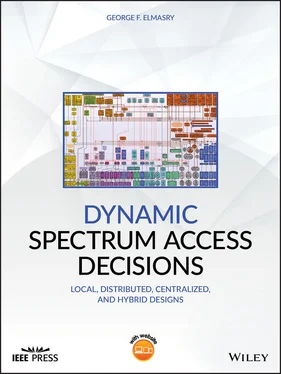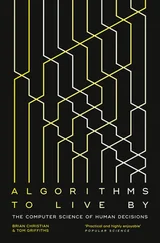3 Distributed cooperative DSA decisions within a net will still use the spectrum resource pool assigned to the net by the centralized arbitrator dynamically to address temporary surges in traffic demand before attempting to request more spectrum resources from the centralized arbitrator.
The centralized DSA arbitrator can make predictive analysis based on node mobility, the spectrum map, and how it changes to create a new spectrum plan. This spectrum plan will have spectrum assignments with changes to most networks in the deployment. These new spectrum plans are meant to stabilize spectrum assignment for longer periods and result in topology and route stability. In other words, the design of a hybrid DSA system with a centralized arbitrator can consider different places for DSA decision making and different types of DSA decisions where some decisions are meant as quick reaction while other decisions are meant to create radical changes that result in more spectrum resources assignment stability and global route stability. In addition to creating stable topology and stable routes, DSA decision stability also reduces the volume of DSA control traffic as information exchange can be just “maintenance” information exchange during stable periods.
Another critical advantage of the use of the centralized DSA arbitrator is the creation of global route tables that avoid routing over the compromised areas where jammers or eavesdroppers are known to be present and avoid routing over energy‐constrained nodes.
With DSA design, there is no single design approach that can be used for all systems. Systems come with limitations, requirements, and vast differences in intended use. Regardless of whether the system under consideration is a civilian or a military system, local, distributed, and centralized DSA approaches have to be weighed in and the place of DSA cognitive engines has to be considered with other cognitive engines the system is using. This chapter is meant to help the reader analyze system limitations, requirements, especially the most critical requirements (e.g., avoid jamming, create low spectrum footprint map, avoid decision rippling, avoid routing over power constrained nodes, and adhere to the maximum bandwidth allocated for control traffic 18), and create a design approach that makes the best of all DSA decision places in a hierarchical DSA system.
While this chapter considered mainly DSA systems for heterogeneous hierarchical MANETs, Chapter 6 addresses dynamic spectrum management in commercial 5G systems to draw parallels and contrasts between DSA design for military communications systems and DSA design for commercial systems eluding to the breadth of dynamic spectrum management needs and challenges. Chapter 7 presents some concepts for the use of 5G in military applications based on DSA concepts. It will be left to the reader to decide if 5G systems can be used for both civilian and military communications infrastructure with no modifications, or if some aspects of 5G can be borrowed for use in military communication systems. Can military networks, which are heterogeneous by definition, have a mix of military waveforms and 5G technologies such as mm‐wave based links and networks? 19
1 Consider Figure 4.5, where we have the master DSA engine being able to establish flows with a TDMA based network through the TDMA waveform agent. Let us assume that the flow unit is defined as F bps, as shown in the figure below. The x axis is the time defined in unit T and the y axis is the flow defined in unit F. The curve defines the traffic demand between two peer nodes over the formed TDMA network. Let us assume the TDMA waveform DSA agent applies the following rules when creating flows (adding or subtracting flows):A flow can be added or subtracted every 0.5T time. The protocols necessitate that flows cannot be added or subtracted in a rate faster than 0.5T.If a fraction of F is needed, the entire flow F is added.If a flow is not needed, its resources are freed. Freeing resources cannot happen at a faster rate than 0.5T.Use the curve to draw the allocated flows versus time over the duration of this traffic demand.Can you find time periods when the allocated bps are less than the traffic demand and time periods when the allocated pbs are more than the traffic demand?State the reasons for encountering gaps between traffic demand and resources allocations.Would you design such a system with TOS bit marking of traffic flows? Why?
2 Consider a MANET with N + 1 nodes. One of these nodes is transmitting a DSA control traffic packet of size L bytes to all the other N nodes. The node under consideration can reach half of the network nodes through one over‐the‐air hop and the rest of the nodes through two over‐the‐air hops. Assume that we need spectrum allocation of 2 Hz per each transmitted bit.If we assume 100% reliability, how much over‐the‐air resources in Hz does it take for the control traffic DSA packet to reach every node in the network, assuming unicast transmission?Repeat (a) assuming broadcast transmission where every one‐hop‐away node that receives the packet will have to broadcast the packet in order to make sure it reaches the nodes that are two over‐the‐air hops away.Which method would you recommend for propagating DSA control traffic between nodes: unicast transmission or multicast transmission where the packet makes use of the multiple access capability of the waveform?
3 For the same MANET discussed in Problem 2 above, let us assume that the DSA control traffic packet is divided into smaller frames where over‐the‐air transmission is for one frame not the entire packet. Let us assume that the DSA control traffic packet is divided into 20 frames.Create a table that shows the probability of delivering the DSA control traffic packet with one transmission when the probability of delivering a frame is 1.0, 0.99, 0.98, 0.97, 0.96, and 0.95, respectively. Assume that losing frames are independent events and that you have to receive every frame in the packet to reconstruct the packet accurately. Make other appropriate approximations if needed.Let us consider the MANET case in problem 2 and consider the one over‐the‐air hop away and the two over‐the‐air hops away transmission cases. Let us consider the unicast transmission scenario. Create the same table as in part (a) if we have to use unicast and transmit the packet two over‐the‐air hops away to reach a node two over‐the‐air hops away from the transmitting node. Assume that packet segmentation to frames occurs with every over‐the‐air transmission.
4 Consider Figure 4.6with a master routing engine, master DSA engine, waveform routing engine, and waveform DSA engine. What is your expectation of reactive routes stability when:master routing engine update time > waveform routing engine update time?master routing engine update time = waveform routing engine update time?master routing engine update time < waveform routing engine update time?
1 Charland, R., Veytser, L., and Cheng, B.‐N., Integrating multiple radio‐to‐router interfaces to open source dynamic routers. In IEEE Military Communications Conference, MILCOM 2012, October 2012.
2 Cheng, J., Wheeler, J., and Veytser, L., Radio‐to‐router interface technology and its applicability at the tactical edge. IEEE Communications Magazine, vol. 50, no. 10, pages 70–77, October 2012.
3 Cheng, B., Charland, R., Christensen, P. et al., Evaluation of multihop airborne IP backbone with heterogeneous radio technologies. IEEE Transactions on Mobile Computing, vol. 13, no 2, February 2013.
4 Cheng, B., Coyle, A., and Wheeler, J., Characterizing routing with radio‐to‐router information in a heterogeneous airborne network. IEEE Transactions on Wireless Communications, vol. 12, issue 8, August 2013.
Читать дальше












